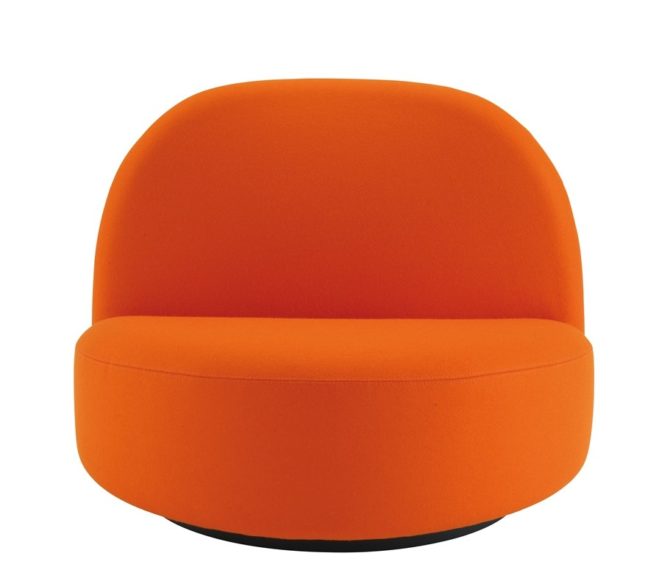Design Now: Back to the Future

Fashion or furniture—many designers love to hop on the time machine for inspirational plunges into the past. Such 20th-century revisits, pepped up with 21st-century twists, are popping up in Paris this spring, showcased at the Maison&Objet trade fair at Villepinte, the Pavillon des Arts et du Design (PAD) in the Tuileries Garden tents and beyond.
As the Oscar-winning film The Artist proved, 1930s style is Right On Right Now. Looking back to that influential decade, young French interior architect Pierre Gonalons has referenced the exceptional furniture of Manik Bagh, the Modernist Indian palace designed in 1930 for the legendary Rao Holkar, Maharajah of Indore, by German architect Eckart Muthesius. Inspired by the palace works of Le Corbusier, Charlotte Perriand, Eileen Grey and Emile-Jacques Ruhlmann as well as Muthesius himself, Gonalons has created five geometric designs: a bookshelf and a console that share the structure of Indore’s master-bed headboard, a sleek rectangular lantern, a modernist chandelier and a tripartite circular mirror, all made in glass and polished chrome. Designed in France, hand produced by Sam & Sara in India, this initial line is being launched along with his other designs in Gonalons’s new Paris gallery, Ascète. A second Manik Bagh edition will be added in the autumn. 2 Galerie Vivienne, Paris 2nd, 01.40.15.07.97. www.ascete.com
The 1930s also turned up on Galerie Guillaume de Casson’s stand at PAD, where Franco-Indian designer Alnoor’s limited-edition Sublimating Dressing Table and its white velvet padded stool combined impeccable Art Deco lines with 21st-century technology and materials. The structure is mirror-polished steel with a smooth white Corian top, but it’s the laser-cut steel mirror with an infrared detection system and LED lighting that provides the surprise. At irregular moments, the message that every single woman before and since Snow White’s stepmother has longed to hear —“You Are Beautiful”—flashes across the glass. The stand-alone full-length Magikal Mirror with the same welcome words sold out at the show. 21 rue de Seine, Paris 6th, 01.45.86.94.76. www.galeriedecasson.com
Sushi swirls
Meanwhile, 1950s fever—in living color—is sweeping into both Gallic furniture and fashion. On the Sentou stand at Maison&Objet, a quirky presentation highlighted Fifties-style sofas and armchairs like the Coogee, in hot orange or swimming-pool turquoise, accompanied by the amoeba-shaped tops of Lalinde coffee tables and Constellation coat racks and mirrors. “It’s the Mad Men effect,” said Sentou communications director Marielle Dhuicque, who added that for her and her friends, the success of MM has also spun off a revival of the dress. 26 blvd Raspail, Paris 7th, 01.45.49.00.05. www.sentou.fr
More mid-century form, but with 21st-century eco-style, takes center stage at the Perimeter Art&Design gallery, where an exhibition called “La Peur de la Couleur” (Afraid of Color) stars the Sushi Sofa by Brazilian designer brothers Humberto and Fernando Campana: off-cuts of rubber, felt and textiles in a palette of Brazilian greens, handcrafted into “sushi” swirls—a recycling tour-de-force produced in a limited edition of two.
The show’s staging by Maryam Mahdavi, based on an essay called Chromophobia by David Batchelor of the London Royal College of Art, divides color tones according to the ages of man, from the honeyed and milky hues of birth to the deep purple and inky tints of final moments. Scary indeed. Until June 7, 2012. 47 rue Saint André des Arts, Paris 6th, 01.55.42.01.22. www. perimeter-artanddesign.com
Hot colors, timeless shapes
The late, great Pierre Paulin’s visionary furniture designs for French president Georges Pompidou at the Elysée Palace, between 1971–74 haven’t taken on a wrinkle, as Ligne Roset’s latest editions of his Elysée seating demonstrate. Within the semicircular shape of the Palace’s smoking room/library, which dates from the days of Napoleon III, Paulin created a tented room in an oatmeal-colored fabric that made the space contemporary by masking the decorative Second Empire grandeur. He then used the semicircular motif to furnish it with timeless half-moon-shaped settees, armchairs and ottomans, also upholstered in oatmeal fabrics. Ligne Roset’s new pieces are true to the original design, but come with heightened comfort in vivid-hued velvets. www.ligneroset.fr
Flashback at PAD: the prize for most outstanding object went to antique dealer Franck Laigneau’s irresistible Jugendstil chairs by turn-of-the- 20th-century Finnish architect Yrjö Blomstedt. Made of wood painted watery green with stylized Symbolist leaves and lotus flowers, the curvy quartet went instantly on VIP night: Two were reserved by the Musée d’Orsay; the other pair was snapped up by a perspicacious Parisian decorator. 29 rue de Bellechasse, Paris 7th, 01.47.05.64.27. www.franck-laigneau.com
Fast forward
So just what time is it on the design clock? Two avant-garde timepiece designs sweep right up to 2012. From Super-ette, a young Luxembourg design company, the Jean clock is a poetic bubble of handblown glass on an aluminum base, a 21st-century wink at the heavy mechanics of 19th-century clocks that once reigned on mantelpieces under bell jars. “Each clock is accomplished with a single blow and is as unique and variable as a small moment in life,” contends its inventor, French designer Pierre Favresse, who says he named it for “a young woman whom you want to look after, but who is free and lives to her own rhythm, just like time and life.” Who said the French weren’t romantic? www.super-ette.com
British designer Michael Young’s colorful 2012 Wall Clock, made of folded Chinese newspapers and aluminum in Hong Kong, was a popular hit on the Modernity Gallery stand at PAD. The Stockholm gallery is devoted to 20th-century Scandinavian furniture and objects, but founder Andrew Duncanson likes to surprise collectors by showing the occasional unique or limited-edition contemporary piece, too. And it works beautifully. On the stand, the great Danish Modern designer Frits Henningsen’s superb 1935 natural leather and teak high wingback chair was a perfect foil to Young’s newspaper-mosaic clock. There is nothing more 21st-century than The Mix. www.modernity.se
Originally published in the May 2012 issue of France Today
Share to: Facebook Twitter LinkedIn Email
Leave a reply
Your email address will not be published. Required fields are marked *



